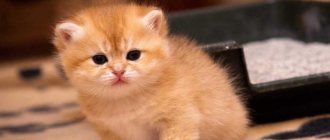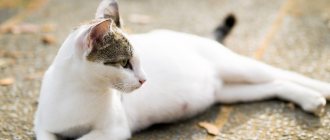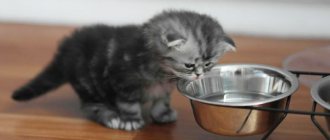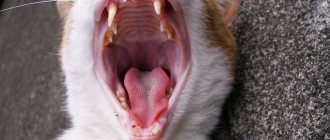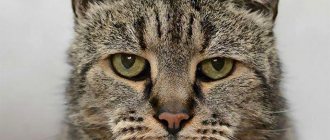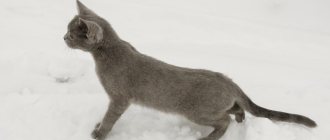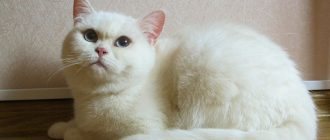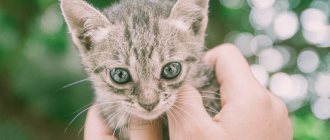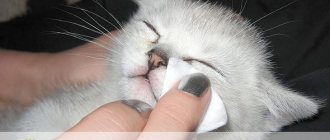Unfortunately, when awaiting the birth of kittens, you must be prepared for the fact that some of them may not survive. In purebred cats, the early mortality rate of kittens is slightly higher than in domestic cats. One study provides data that about 7% of purebred kittens are stillborn, 9% die during the first eight weeks of life (mostly from the first to the third week). The number of kittens surviving after 8 weeks of life varies between breeds (from 75% to 95%), Persian kittens are the most likely to die.
Most kittens that are not destined to survive die before birth (they are stillborn) or in the first week of life. The number of deaths in kittens that lived for more than a week is significantly less. As a rule, while the cat is nursing kittens, death occurs from “non-infectious” causes; mortality from infectious diseases increases after the kitten is taken from its mother. This is because kittens receive protection against many infections through their mother's milk. Kittens that die between birth and weaning are called “fading.”
Newborn kittens may die suddenly or decline gradually over several days. Unfortunately, the clinical signs of many diseases affecting newborn kittens are very similar and vague. If healthy kittens tend to gather in a group and sleep between feedings, then sick kittens often lie separately, are more restless, suck poorly, and often squeak (while they have enough strength to do so).
Newborn kittens are more vulnerable because their body temperature regulation mechanisms and immune system are still developing, and they have an increased risk of dehydration and low blood sugar (hypoglycemia).
Causes of early mortality of kittens.
Hypothermia
(hypothermia). Newborn kittens are at risk of hypothermia because their bodies are unable to maintain body temperature, making them dependent on the cat and the temperature in the room. Hypothermia, in particular, is dangerous because it can cause a decrease in breathing and heart rate, which leads to cardiovascular failure. Also, with hypothermia, kittens often cannot suckle well, which accelerates the development of problems. Rectal temperature in kittens should be between 35-37°C in the first week, 36-38°C in the second and third weeks, and reaches a normal adult cat temperature of 38-39°C by the fourth week of life.
Low sugar level
in the blood (hypoglycemia). Newborn kittens need a lot of energy, but they have no reserves to conserve it, so they are completely dependent on their mother's milk. Sick kittens may not consume the required amount of milk, which quickly leads to the development of hypoglycemia. This can manifest itself in weakness, decreased temperature, squeaking, difficulty breathing, and convulsions.
Dehydration
(dehydration). At an early age, the risk of dehydration in kittens is increased, since their body contains a relatively high amount of fluid, and the mechanisms of protection against water loss have not yet been fully formed; water is quickly excreted through the kidneys, lungs and skin. Diarrhea also increases water loss. Normally, newborn kittens require approximately 130-220 ml/kg per day of water, while an adult cat only needs 50-65 ml/kg. Dehydration develops quickly when there is a lack of milk intake or increased water loss (usually as a result of overheating or diarrhea).
Prevention
To prevent your pet from refusing to eat, the following simple measures should be followed:
- normalize diet;
- do not allow the cat to be outside uncontrolled;
- diversify your diet;
- feed the animal only premium and super-premium mixtures;
- exclude food from the human table;
- choose food in accordance with the cat’s taste preferences;
- avoid stressing the animal;
- sterilize your pet in time or provide him with a full sex life;
- carefully transfer to a new diet, especially kittens;
- prevent the animal from overheating in the hot season;
- vaccinate annually;
- regularly deworm and treat for external parasites;
- Long-haired breeds should be combed out and given pastes to prevent the formation of hairballs;
- Bring your pet to the veterinarian regularly for checkups.
The most common causes of early kitten mortality.
Reasons related to childbirth and mother.
Hypoxia
(lack of oxygen), injuries, hypothermia. Kittens born after a difficult birth (dystocia) are much more likely to die as infants. This occurs as a result of possible birth injuries and (or) hypoxia. Research shows that cats with extreme features, such as the flat face of the Persian, are more likely to have difficulty giving birth, likely due to a combination of features such as the kitten's relatively large size, large head, and the cat's narrow pelvis. Due to the lack of oxygen during birth, kittens may be born dead or too weak to suckle enough milk afterwards.
First birth
at the cat. Kittens from the first litter have a higher mortality rate on average, likely due to the cat's inexperience, injury, and possible cannibalism. Cats that have given birth multiple times (more than five times) may also experience difficulty during labor.
Obesity
cats. Mortality among kittens whose mother is overweight also increases.
Others
Reasons: lack of milk, mastitis, abandonment of kittens.
Congenital anomalies in kittens.
Congenital anomalies are physical defects that are present from birth. These can be both genetic abnormalities and disorders during intrauterine development (for example, due to the use of medications, past illnesses, etc.), leading to the formation of defects in the fetus. The most common birth defects are:
- Cleft palate;
- Umbilical hernia;
- Skeletal defects;
Kittens with significant defects are usually stillborn or die in the first days of life. Moderate disorders lead to the decline of kittens or may appear at an older age. Since inbreeding also increases the risk of inherited diseases, hereditary disorders are more common in purebred cats.
The kitten is underweight.
Low weight kittens are more at risk of hypothermia, dehydration, respiratory problems and infectious diseases, which significantly increases the risk of early death. Kittens may be born underweight due to maternal malnutrition, disease, birth defects, or other causes that result in poor blood supply to the placenta.
The average weight of a newborn kitten for domestic cats and most pedigree cats ranges from 90 to 100 grams, although some breeds have a normal kitten weight that is less (for example, Oriental cats) and some more (Maine Coons). If a kitten weighs less than 75g, the likelihood of death is quite real.
Poor conditions for the development of a kitten.
The environment significantly influences kitten mortality:
Air temperature
. Room temperature is very important for the proper development of kittens. If kittens are cold, they very quickly get tired of sucking milk, which leads to hypothermia and hypoglycemia. To maintain temperature (especially for orphaned kittens), it may be necessary to warm their box to a temperature of 29-32°C, and the kittens should be able to freely move away from the heater to a cooler area. By 7-10 days the temperature can be gradually reduced to 27°C, and by the end of the first month of life - to 22-25°C.
Poor hygiene
. Increases the risk of infectious diseases.
A large number of kittens
. Increases the risk of infectious diseases and malnutrition as a result of competition for food (milk).
Excessive cat care
. Constant licking of kittens can limit their time for feeding, and in nervous cats even lead to cases of cannibalism. Since newborn kittens cannot shiver, which prevents them from maintaining body temperature, they may become hypothermic, which in turn leads to a further decrease in activity and milk output.
Improper cat nutrition.
It is very important that the food meets the needs of a nursing cat, since the quality of milk depends on it, which greatly affects the health of kittens. It is advisable to feed your cat high-quality food designed specifically for nursing cats.
A lack of milk produced by a cat can have the following reasons:
Insufficient milk intake in a kitten can occur as a result of:
- Deterioration in health or weakness;
- Competition with other kittens;
- Poor living conditions;
Signs of low milk supply for kittens.
For control, kittens should be weighed immediately after birth, weighed daily during the first week and twice a week starting in the second week of life. Normal indicators must meet the following parameters:
- In the first day, the kitten can lose no more than 10% of its weight;
- From the second day the kitten should gain 10-15g/day (5-10%);
- The kitten's weight should double in 1-2 weeks;
Any weight loss (or lack of weight gain) should be cause for concern.
If a cat does not produce enough milk, the kittens need additional nutrition.
Neonatal isoerythrolysis.
For some cat breeds, neonatal isoerythrolysis is a fairly common cause of death in kittens. The cause of death in this case is the incompatibility of the blood groups of the cat and the kitten.
Infectious diseases (viral, bacterial, parasitic).
The kitten should begin suckling within the first 2 hours of life. Kittens receive antibodies from the cat's milk by absorbing them during the first 16 to 24 hours of life, so it is important that they nurse well during this period. Milk is necessary not only for good nutrition, but also for the acquisition of maternal derived immunity, which protects them from infections.
The effectiveness of maternal immunity usually decreases at 3-4 weeks of life, individually for each kitten; by this time the amount of antibodies should be sufficient. A kitten's own immunity has not yet developed, and since most vaccination programs begin after 8 weeks, kittens are at increased risk of infectious diseases during this period. Kittens that suckle poorly will not receive enough colostrum and will therefore not be protected by maternal immunity, becoming especially susceptible to infectious diseases at an early age.
Among the factors that increase the risk of infectious diseases in a kitten are the following:
- Insufficient amount of colostrum;
- Malnutrition;
- Low birth weight;
- Lack of oxygen during childbirth;
- Congenital diseases (especially of the immune system);
- Stress
- A large number of kittens in the litter;
- Poor sanitary living conditions;
- Low ambient temperature;
Respiratory and intestinal infections affect kittens especially often.
Among the infectious agents of diseases leading to the death of kittens, the most dangerous are:
In kittens, bacterial infections are often secondary to viral infections (cat flu, leukemia, immunodeficiency, peritonitis, parvovirus), although they can also be primary. Clinical signs depend on the nature and severity of the infestation and may include diarrhea, cough, difficulty breathing, arthritis, dermatitis, as well as less obvious signs more typical of fading kittens. Ultimately, many of these infections lead to septicemia (a form of sepsis where there are large numbers of bacteria in the blood) and death.
Intestinal parasites (including roundworms and coccidia) can become a problem if the cat is not treated for parasites or has poor hygiene. Severe parasite infestations can worsen the general condition of kittens, causing loose or bloody stools, loss of appetite, bloating, weight loss, and sometimes death.
Symptoms signaling disease
Vomiting is a symptom of many pet illnesses . The nature of the masses and their composition differs depending on the type of pathology.
Appearance of white foam
Vomiting is a sign of many diseases in pets.
The appearance of white foam is not always dangerous. This phenomenon is often observed in hungry pets. Long intervals between meals contribute to the fact that the empty stomach begins to produce mucus, which suppresses gastric juice. A mixture of juice, mucus and air forms such foam.
If white foam appears often enough, then there is a high probability of stomach disease.
Vomit with bile
Bile is a yellow-colored impurity in vomit. It causes nausea due to stomach irritation. In isolated cases, the appearance of bile indicates high fat content of food or swallowing large pieces.
Be sure to read:
A cat often burps: causes, symptoms, what to do when vomiting after eating, prevention, what not to do
Frequent vomiting with bile signals the development of diseases of the liver, pancreas or intestines.
Vomiting food
The appearance of masses of undigested food indicates that the pet is overeating or swallowing too large pieces. The attack appears once.
If this phenomenon is repeated frequently, then there is a likely risk of developing stomach diseases (ulcers, gastritis or colitis). A sick stomach cannot cope with the digestion of food and becomes empty.
Blood impurities
The appearance of blood is a dangerous sign and requires immediate medical attention.
The appearance of masses of undigested food indicates that the pet is overeating or swallowing too large pieces
In this case, there may be two options:
- Impurities of a bright scarlet hue indicate the presence of open wounds in the oral cavity or esophagus.
- Brown impurities appear when there are wounds in the stomach or intestines.
Factors that cause the appearance of wounds may include the ingress of foreign objects, the development of an ulcer or tumor, liver or intestinal diseases.
The kitten squeaks. Why is the little kitten screaming?
Your kitten is nursing, but squeaks . There are several reasons why a small kitten screams.
— If a small kitten squeaks , then first you need to check the baby’s palate. Gently pick up the kitten in your hands and hold it firmly but gently. Insert the tip of your finger into his mouth (preferably from the side) and look inside to see if there is a cleft? If not, great. But if you notice a cleft palate in your baby, take him to the veterinary clinic; an experienced veterinarian will immediately tell you whether the kitten’s cleft palate is compatible with life. Unfortunately, most often these babies are euthanized.
— A newborn kitten needs to be weighed constantly. Immediately after birth and every day until 2 weeks of age. Then you can do it less often.
After checking the palate cock the kitten and check if it is gaining weight (at least 7 grams per day).
It's good if everything is fine with your weight. But if the baby is not gaining weight, the cat may have little or no milk and the kitten is hungry. Start feeding your baby. This should be done after he has sucked the cat's breast. And control your weight.
You can watch the process of feeding a newborn Maine Coon kitten in this video.
— A kitten can scream if it’s cold . Place him on a heating pad while the cat is not around. Due to a decrease in body temperature, the kitten's sucking reflex may disappear and a hungry kitten will squeak.
— The kitten squeaks if the cat doesn’t lick him (doesn’t “pee, poop”). This happens if the cat is not experienced (firstborn) or something is bothering her (mastitis, endometritis, retained placenta). If the cat is inexperienced, you will have to care for the newborn yourself and at the same time try to teach the cat how to properly care for the baby. Using cotton wool and warm water, gently stroke the kitten to stimulate defecation and urination every 3 hours (before feeding). Some people find it helpful to spread sour cream or butter on the kittens' butts, then the cat begins to lick them with pleasure.
But if something is bothering the cat and she gets sick, then you will have to simultaneously care for the kittens and treat the mother. After recovery, the cat will take care of her kittens herself.
As you can see, there are many reasons why a kitten squeaks. A small kitten screams from hunger, from hypothermia, and from a bloated tummy, and sometimes you come across just very talkative babies who gain weight well, but love to scream.
In most cases, you can easily help the kitten, but sometimes the help of a qualified specialist is required.
Did you like the article and was it useful? Please share with your friends.
Other interesting articles on our website:
• Weak newborn kitten
• First vaccination for a kitten
• Where can I buy a kitten
• Vaccination against shingles
Signs of poor appetite
If an animal sometimes refuses to eat, then there is nothing wrong with that. You may not always notice weight loss right away. Cats that live indoors need less food. Therefore, they may sometimes not feel hungry and drink only water.
Loss of appetite may be a sign of serious problems
Veterinarians identify several thinness indices. When exhausted, the animal's ribs clearly appear; if you look at it from above, its figure will resemble an hourglass. The stomach is strongly retracted.
If the cat is underweight, the ribs and spine will be clearly palpable, and there will be no fat layer. With normal weight, the animal looks like an even rectangle from above. The ribs can be felt during normal examination, but a small amount of fat will be felt.
Important! Being overweight is just as dangerous as being underweight.
The owner should only start to worry if the cat is emaciated or underweight. In this case, it is better to consult a veterinarian to determine the cause of the weight loss.
Sometimes the condition is accompanied by additional symptoms - vomiting, drowsiness, lethargy. All this may indicate the development of a serious illness. A particularly dangerous sign is refusal of water.
The cat is lethargic and sleeps all the time: what is the reason?
Among the pathological causes of lethargy are the following:
- poisoning,
- hormonal disorders after childbirth or as a result of using contraceptives,
- side effects of corticosteroid anti-inflammatory drugs,
- musculoskeletal pathologies,
- infectious diseases,
- worms;
- anemia;
- hypovitaminosis;
- tumors;
- chronic diseases.
Stress causes ambivalence in cats. The pet may become sleepy or, conversely, show aggression.
When do you need veterinary help?
Many owners call a veterinarian for their pet on the first or second day after moving, when they see that it does not leave the corner for a long time. Or they go looking for advice on forums on what medications they can give to their pet. We categorically do not recommend doing this.
You should call a veterinarian or take your cat to the clinic only if:
- There are obvious signs of poor health of the animal: constant nausea, severe drowsiness, loss of tufts of hair;
- The animal does not leave its corner for more than 4 days and refuses to eat and go to the toilet;
- The animal is lethargic, it does not try to defend itself when you want to pick it up.
There is no point in giving the animal pills and injections once again. A trip to the vet is another stressful experience for your pet, so it’s best to avoid it.
Cat behavior after moving
Immediately after moving to a new apartment, the animal is usually slaughtered in a place where it feels safe. For example, under the bed or between cabinets. A small space around a cat allows her (him) to feel safe.
The best decision on the part of the owners at such a moment is to make the place chosen by the pet as comfortable as possible for it. For example, put his favorite blanket in this place or put his scratching post - any items that you took from the old house will do.
Important
There is no need to forcefully try to remove an animal from a place where it feels safe. His self-preservation instinct comes first, and it can lose his temper, start hissing, scratching, and thereby his stress level will increase even more.
Before moving into a new apartment with a pet, we recommend that you try to cover all the places where the cat can “hide” with danger to its health. It is best for the animal to choose a place from where you can see it, and where it can see you and the environment. A bad option for the first place for a cat to stay in a new apartment is behind the sofa, bed and other furniture. This will not only be additional stress for the animal, the lack of visual contact with the owner, but also potentially traumatic.
